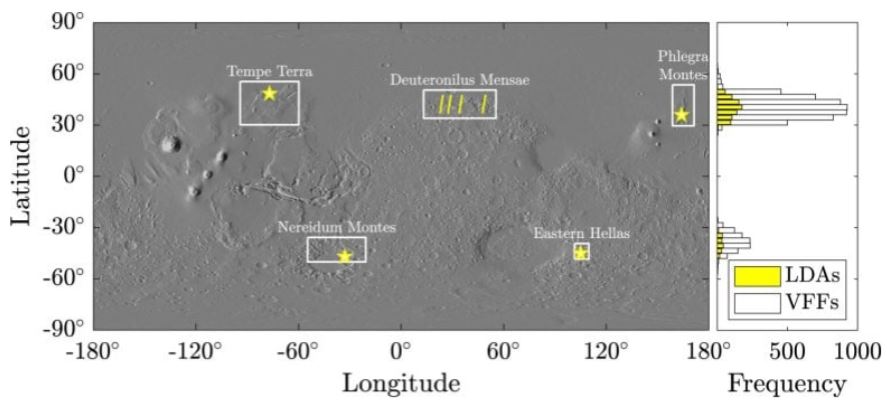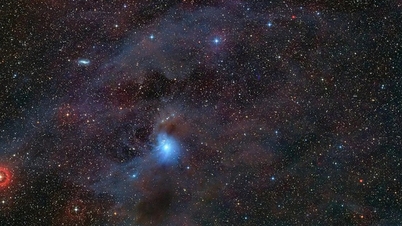
Beneath the dusty slopes of Mars lie glaciers that look like frozen honey, but new research suggests they are much purer than previously thought. Image credit: Shutterstock
On the slopes and in impact craters of Mars, rocks once thought to be dusty and frozen in place are actually glaciers moving so slowly they are almost imperceptible. For years, scientists believed they were mostly rock with a small amount of ice.
However, studies spanning two decades have shown that some of these glaciers are made up mostly of ice, with only a thin layer of dust and rock on the surface. Now, a study published in the journal Icarus has confirmed that this phenomenon is not limited to a few isolated spots but is widespread across the entire red planet. The glaciers here are more than 80% water ice, with an astonishing purity that reflects the history of Mars' climate and promises to be a valuable resource for future exploration.
The work was led by Yuval Steinberg, a graduate student at the Weizmann Institute of Science in Israel. Co-authors include Oded Aharonson and Isaac Smith, two senior scientists at the Planetary Science Institute in Tucson, who are also academically affiliated with the Weizmann Institute of Science and York University. “This study highlights how NASA programs promote science not only in the United States but also reach students around the world ,” said Aharonson.

This is an example of a debris-covered glacier on Mars. New research on these features suggests they are more pristine than previously thought. Credit: NASA/JPL-Caltech/University of Arizona
“Unveiling the Dust Layer on Mars”
In reviewing previous studies, the team found that analysis of debris-covered glaciers was inconsistent and difficult to compare. “Researchers used different techniques at different sites, and the results were not easily compared,” Smith explains. “Some sites had never been studied at all, or had only partial analyses.”
To address this, the team developed a standardized method for examining debris-covered glaciers. They focused on two metrics: dielectric properties (which show how fast radar waves travel through a material) and tangent loss (which shows how much energy is absorbed). These parameters help determine the ratio of ice to rock inside the glacier, something surface observations can’t reveal because of the dust and rock cover.

The five sites the team examined were examined for their glacier purity. The fact that these distinct sites had similarly high ice/rock ratios implies that Mars experienced one or more widespread ice ages with similar properties, the team said. Source: Steinberg et al.
Comparing the scale of the entire planet
Using the SHARAD (SHallow RADar) instrument on the Mars Reconnaissance Orbiter, the team expanded their study to five locations spread across Mars. The results surprised them: all the glaciers, even those in opposite hemispheres, had nearly identical properties.
“This is important because it suggests that the mechanisms of formation and preservation are probably similar everywhere,” Smith said. “From this, we can conclude that Mars has experienced one or more major ice ages with similar characteristics. Combining multiple sites and techniques has for the first time helped us unify our understanding of these glaciers.”
Determining the minimum purity of ice not only sheds light on the formation and preservation of glaciers on the red planet, but also has practical implications for future exploration missions, where the use of local water resources will become key.
The next step is for the research team to expand their survey of other glaciers on the red planet, to further consolidate their initial findings and decode the long-standing mystery shrouded in Martian dust.
Source: https://doanhnghiepvn.vn/cong-nghe/kham-pha-gay-soc-song-bang-tren-sao-hoa-chua-hon-80-la-bang-tinh-khiet/20250903072053947




![[Photo] Prime Minister Pham Minh Chinh chairs a meeting of the Government Standing Committee to remove obstacles for projects.](https://vphoto.vietnam.vn/thumb/1200x675/vietnam/resource/IMAGE/2025/10/06/1759768638313_dsc-9023-jpg.webp)
![[Photo] Prime Minister Pham Minh Chinh chaired a meeting of the Steering Committee on the arrangement of public service units under ministries, branches and localities.](https://vphoto.vietnam.vn/thumb/1200x675/vietnam/resource/IMAGE/2025/10/06/1759767137532_dsc-8743-jpg.webp)






























































































Comment (0)